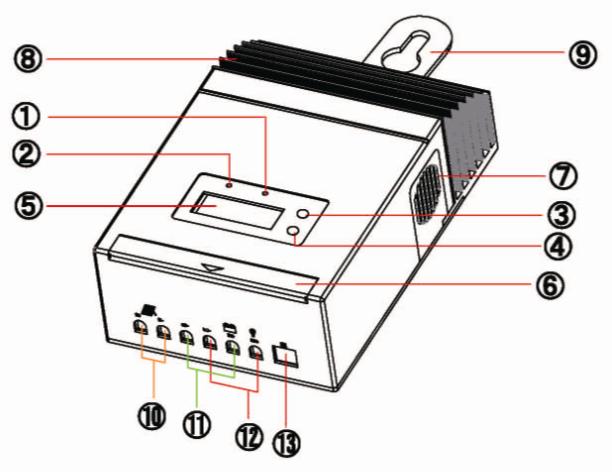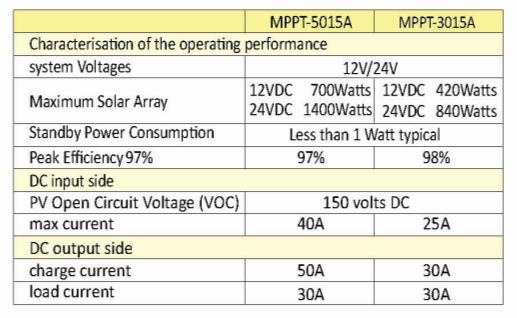SUN-MPPT-3015A Solar charge controller 30A
- Loading Port:
- Ningbo
- Payment Terms:
- TT OR LC
- Min Order Qty:
- -
- Supply Capability:
- 500 kg/month
OKorder Service Pledge
OKorder Financial Service
You Might Also Like
1.0 General Information
1.1 Overview
Thank you for selecting the MPPT solar charge controller.The MPPT is essentially a smart DC to DC converter which has been optimized to harvest maximum energy from the PV array in battery based solar electric systems by using a variety of maximum power point tracking (MPPT) strategies. The controller’s secondary objective is to ensure that the batteries receive a full charge without becoming overcharged. This is accomplished through a four stage charging process. Please take the time to read this operator’s manual and be familiar with the controller.This will help you make full use of the many advantages the MPPT can provide for your PV system.
1.2 Features
1 - Battery Status LED Indicator:An LED indicator that shows battery status or system errors.
2 - Charging Status LED Insdicator:An LED indicator that shows charging status and overvoltage of pv.
3 - Setting Button1:Set load work mode,battery type and max charge current.
4 - Setting Button2:Set load work mode,battery type and max charge current(in manual mode used for load ON/OFF).
5 - LCD Digital Display:Dispaly the system status
6 - Wiring Box Cover:Sheet metal wiring box cover protects power connections
7 - FAN:FAN to dissipate Internal circuit heat
8 - Heatsink:Aluminum heatsink to dissipate controller heat
9 - Mounting Hanger:Keyhole slot for mounting
10 - Solar Module Terminals:Connect solar modules
11 - Battery Terminals:Connect batteries
12 - Load Terminals:Connect loads
13 - RJ45 Communication Interface:Communicate with personal computer

2.0 General Information
The mounting location is important to the performance and operating life of the controller. The environment must be dry and protected from water ingress. If required, the controller may be installed in a ventilated enclosure with sufficient air flow. Never install the MPPT unit in a sealed enclosure. The controller may be mounted in an enclosure with sealed batteries, but never with vented/ flooded batteries. Battery fumes from vented batteries will corrode and destroy the MPPT circuits. Multiple MPPT can be installed in parallel on the same battery bank to achieve higher charging current. Additional parallel controllers can also be added in the future. Each MPPT must have its own solar array.
CAUTION: Equipment Damage or Risk of Explosion
Never install the MPPT in an enclosure with vented/Flooded batteries. Battery fumes are fl ammable and will corrode and destroy the MPPT circuits.
CAUTION: Equipment Damage
When installing the MPPT in an enclosure, ensure suffi cient ventilation. Installation in a sealed enclosure will lead to over-heating and a decreased product lifetime.
NOTE : Mounting
When mounting the MPPT ,ensure free air through the controller heat sink fins. There should be at least 150mm of clearance above and below the controller to allow for cooling. If mounted in an enclosure, ventilation is highly recommended.
3.0 Specifications
Electrical

NOTE:

All charging voltage setpoints listed are for 12 Volt systems. Multiply 2X for 24 Volt systems.
Battery Charging Charging algorithm 4 - stage Charging stages Bulk, Absorption, Float, Equalize Temperature compensation coeffcient -5 mV / °C / cell (25 °C ref.) Temperature compensated setpoints Absorption, Float, Equalize, HVD Charging Setpoints:
- Q:Can a solar controller be used in harsh weather conditions?
- Yes, a solar controller can be used in harsh weather conditions. Most solar controllers are designed to withstand extreme temperatures, humidity, and other environmental factors. They are built with rugged and durable materials that protect the internal components from damage. Additionally, many solar controllers have built-in protection features like overcharge, over-discharge, and short-circuit protection, which further enhance their ability to withstand harsh weather conditions.
- Q:How does a solar controller handle the protection against short circuits?
- A solar controller handles protection against short circuits by constantly monitoring the current flowing from the solar panels. If a short circuit occurs, the controller immediately detects the sudden increase in current and activates its built-in short circuit protection mechanism. This mechanism typically involves quickly disconnecting the solar panels from the charging system to prevent any damage to the panels, batteries, or other connected devices. The controller then attempts to restore the charging process once the short circuit is resolved.
- Q:Can a solar controller be used with different types of solar inverters?
- Yes, a solar controller can be used with different types of solar inverters. The solar controller acts as a bridge between the solar panels and the inverters, regulating the flow of power and ensuring proper charging and protection of the batteries. As long as the solar controller is compatible with the voltage and current ratings of the solar panels and batteries, it can be used with various types of inverters.
- Q:What is the maximum cable size that can be used between the solar panels and the load?
- The maximum cable size that can be used between the solar panels and the load depends on various factors such as the distance between the panels and the load, the amount of power being generated by the panels, and the electrical specifications of the load. It is best to consult the manufacturer's guidelines or seek advice from a qualified electrician or solar professional to determine the appropriate cable size for your specific system.
- Q:Can a solar controller be used with a solar-powered sports facility?
- Yes, a solar controller can be used with a solar-powered sports facility. A solar controller is an essential component that regulates the charging and discharging of batteries in a solar power system, ensuring optimal performance and preventing damage. In a solar-powered sports facility, the solar controller would help manage the flow of energy from the solar panels to power the facility's electrical needs and store any excess energy in batteries for later use.
- Q:Can a solar controller be used with solar-powered water heaters?
- Yes, a solar controller can be used with solar-powered water heaters. A solar controller helps regulate the operation of the solar heating system by controlling the flow of heat or electricity from the solar panels to the water heater. It ensures optimal performance and efficiency of the solar-powered water heater by monitoring and adjusting various parameters such as temperature, pressure, and flow rate.
- Q:Can a solar controller be used in a solar-powered spacecraft propulsion system?
- Yes, a solar controller can be used in a solar-powered spacecraft propulsion system. A solar controller is responsible for regulating and optimizing the charging of batteries in a solar power system. In a solar-powered spacecraft propulsion system, solar panels collect energy from the sun and convert it into electrical power. This power is then stored in batteries, which can be used to power various systems, including the propulsion system. The solar controller ensures that the batteries are charged efficiently and protects them from overcharging or discharging.
- Q:Can a solar controller be used in a solar-powered airship?
- Yes, a solar controller can be used in a solar-powered airship. A solar controller regulates the flow of electricity from the solar panels to the battery, ensuring optimal charging and preventing overcharging. In a solar-powered airship, the solar controller would play a crucial role in efficiently harnessing solar energy and storing it in the onboard battery system, thus powering the airship's operations.
- Q:Can a solar controller be used with a solar inverter?
- Yes, a solar controller can be used with a solar inverter. A solar controller helps regulate and optimize the charging and discharging of batteries in a solar power system, while a solar inverter converts the direct current (DC) generated by solar panels into alternating current (AC) for use in powering electrical devices. Both components work together to effectively manage and utilize solar energy in a renewable energy system.
- Q:What is the role of a battery equalization function in a solar controller?
- The role of a battery equalization function in a solar controller is to balance the charge levels of individual battery cells or groups of cells within a battery bank. This function ensures that each cell or group is charged and discharged evenly, preventing any imbalances that can lead to reduced battery performance or premature failure. By equalizing the charge levels, the battery's overall capacity and lifespan are optimized, resulting in more efficient and reliable energy storage for the solar system.
1. Manufacturer Overview |
|
|---|---|
| Location | |
| Year Established | |
| Annual Output Value | |
| Main Markets | |
| Company Certifications | |
2. Manufacturer Certificates |
|
|---|---|
| a) Certification Name | |
| Range | |
| Reference | |
| Validity Period | |
3. Manufacturer Capability |
|
|---|---|
| a)Trade Capacity | |
| Nearest Port | |
| Export Percentage | |
| No.of Employees in Trade Department | |
| Language Spoken: | |
| b)Factory Information | |
| Factory Size: | |
| No. of Production Lines | |
| Contract Manufacturing | |
| Product Price Range | |
Send your message to us
SUN-MPPT-3015A Solar charge controller 30A
- Loading Port:
- Ningbo
- Payment Terms:
- TT OR LC
- Min Order Qty:
- -
- Supply Capability:
- 500 kg/month
OKorder Service Pledge
OKorder Financial Service
Similar products
New products
Hot products
Hot Searches
Related keywords



























